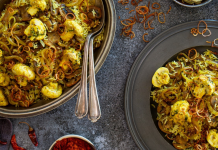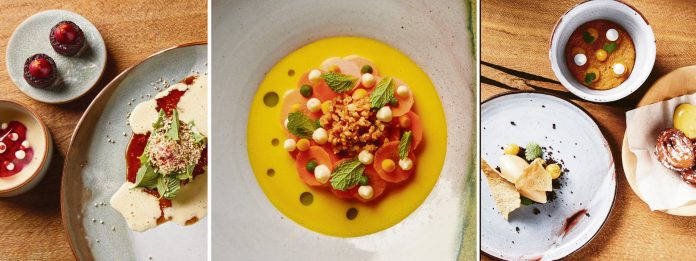
From lamb neck served with beetroot and pink pepper to madumbe and guavadilla, these dishes will dance on your palate and delight all of your senses.
Sustainability and seasonality are at the core of everything chef Johannes Richter and his wife Johanna do at Summerhill Guest Estate, which is home to The LivingRoom, their multi-award-winning restaurant which is a must-visit destination for foodies and fine-dining enthusiasts.
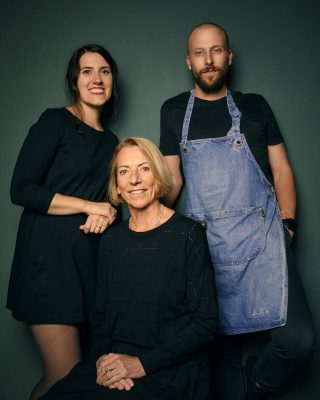
Unearthing the history behind the estate, which was pioneered 25 years ago by Johannes’ mum, Christine, gives outsiders a rare glimpse into the world of a widowed mother determined to create a beautiful life for her children – one that would eventually lead to edible adventures around the dinner table.
Decades down the line, her sacrifice is the foundation on which Johannes and Johanna have built their success story, and there is so much love and passion that goes into what this Cowies Hill culinary couple do. Balancing their lives in and out of the kitchen – they’re young parents too – they work side-by-side, alongside Christine, Tuesdays to Saturdays to showcase KZN’s culinary diversity … from the garden to your plate.
Between Johannes’ fine French training and passion for Japanese techniques, Christine’s warm and helpful front-of-house demeanour and Johanna’s excellent sommelier skills, an evening spent in their company is a once-in-a-lifetime, local, gastronomical experience.
A visual feast for the eyes, with a degustation dinner menu of note and top-notch hospitality to boot, Johannes and Johanna offer menus – driven by an innovative, hyper-seasonal and endemic approach to cooking – comprising five or seven courses, with brilliant vegetarian options and great consideration for dietary restrictions.
Committed to using only the freshest, locally sourced ingredients, they grow their own fruit, vegetables and herbs in their garden, and for the rest, everything else, including their custom-made ceramic plates, is sourced locally. With a strong focus on sustainability and ethical farming practices, and a conscious and deliberate effort to create their menu with as low an impact as possible, their plating, exquisite and artistically pleasing, is designed to complement each dish that adorns it.
When it comes to the vino, these are all tried, tested and of course enjoyed by Johanna. She handpicks unique varietals from smaller South African wine makers and producers who share the same passion she does, as well as the couple’s thoughts on the ecological footprint they leave. For those who don’t drink, a treat awaits through a well thought out non-alcoholic pairing to go with each dish, using syrups, kombuchas, juices and tonics made in-house.
Sweet, sour, salty, cultural and everything in-between, the whole experience really is just indescribable! To tease your taste buds, Johannes and Johanna have shared three seasonal dishes – paired with luscious wines – that are an adventure to re-create in an amateur kitchen.
Details: Call or WhatsApp: 063 529 1966; e-mail [email protected] or follow them on IG: @thelivingroomatsummerhill
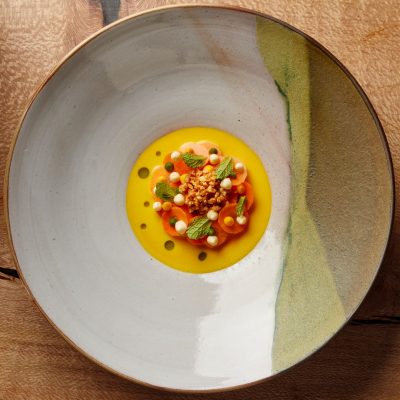
The ordinary carrot, miso macadamia and mint
Serves: 4 | Preparation time: 40 min
Paired with: Sijnn White (Chenin, Verdelho, Viognier, Rousanne), a wine with a lot of texture and structure that boasts a very savoury finish with fine acidity. In combination with the sweet, salty and umami flavours in the carrot dish, it brings all the flavours together nicely.
What you’’ll need:
Buttered carrot juice: 1kg carrot; 150g butter; 10g salt, 10g apple cider vinegar
Carrot pickle: 2 carrots peeled and thinly sliced on mandolin; pinch salt; sugar and apple cider vinegar to taste
Miso Macadamia: 150g roasted macadamia; 50g sugar; 30g miso
Mint Oil: 200g fresh mint; 200g neutral oil (sunflower or rapeseed)
Garnish: Fresh mint
How to make:
Buttered carrot juice: Peel and juice carrots. Bring the carrot juice to a boil and blend with the other ingredients into a hot juice. Only reheat again before serving.
Carrot Pickle: Slice carrots thinly, and season to taste – sweet, sour and salty.
Miso macadamia: Heat a pan to medium heat. Add the sugar and a tablespoon of water to the pan and caramelise until golden. Add the miso and macadamia nuts and mix together swiftly, set as a brittle on a sheet of baking paper. Once hardened, chop the brittle into coarse pieces.
Mint oil: Blanch the fresh mint and squeeze out all excess water. Blend blanched mint with the oil and pass through a fine sieve.
To serve: Layer the carrot onto the bottom of the plate. Sprinkle with the miso macadamia nut brittle. Garnish with fresh mint. Decant the carrot juice into a small jug and serve on the side.
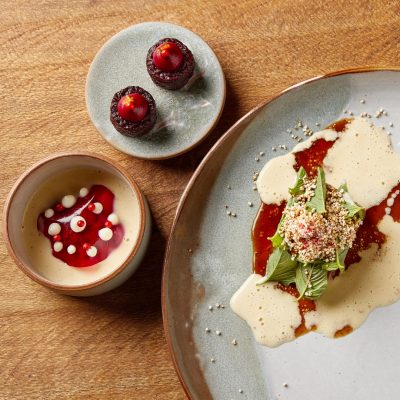
Lamb neck, beetroot & pink pepper
Serves: 4 | Preparation time: 6 hours
Paired with: Weather report Atlas 2020. Winemaker: Christopher Keet. A 100 % Cabernet Franc from different vineyards in the Western Cape, with a small production of 4 000 bottles. With its medium body, dense fruit core and lightly smoky, spicy nuances, it works well with the lamb, the fruitiness of the beetroot and the spices in the red pepper sauce.
What you’’ll need:
Braised lamb neck: 2 whole lamb necks (cut in half by butcher, length ways); 2 carrots peeled, cleaned and diced; 2 onions peeled and diced; 2 sticks of celery; 1 tomato roughly diced; 2 garlic cloves peeled and crushed; 5 bay leaves; 1 tbsp. pink pepper corns; 500ml red wine; 2 tbsp. corn starch; 1/2 l water; salt, sugar and red wine vinegar to taste; neutral oil (sunflower, rapeseed, grape-seed)
Beetroot relish: 1kg beetroot boiled with skin; 200g Msobo Jam; balsamic vinegar; salt
Pink pepper corn sauce: 1 onion peeled and finely diced; 1 garlic; 50g pink pepper corns; 300ml white wine; 125ml sour cream; neutral oil
Garnish: Amaranth seeds (health shops); amaranth leaves (Imbuya, cane herbs); neutral oil to deep fry; salt to season
How to make:
Braised lamb neck: Preheat oven to 180°C. Season lamb neck with salt, and fry in casserole with neutral oil, bay leaves and pepper corns. Once brown, remove lamb neck from casserole and sauté all vegetables until caramelised. Add red wine and water and bring to boil. Add lamb necks, cover with lid and put in oven with 180°C for five hours. Remove lamb neck after five hours and let it cool down. Once you are able to touch it, gently remove all bones and sinew. Strain remaining sauce and thicken with corn starch – dissolve starch in red wine and add to sauce. Then add deboned lamb neck and season to taste with salt, sugar and vinegar.
Beetroot relish: Grate boiled and peeled beetroot on finest setting of grater (use gloves if needed). Squeeze out any exes liquid. Add Msobo jam and season with salt and balsamic vinegar.
Pink pepper corn sauce: Sautee onion and garlic. Add white wine, reduce by half. Blend in sour cream with a stick blender and pass. Add pink pepper corns, simmer for two minutes and blend. Serve frothed.
Popped amaranth: Preheat oil to 190°C. Put 2 tbsp. of amaranth seeds in a sieve and puff for approximately 20 seconds in hot oil. After deep-frying place on three layers of paper towel to drain excess oil and season with salt
To serve: Place lamb neck on plate, glazed with jus. Garnish with fresh amaranth leaves and popped amaranth. Finish off with pink pepper corn sauce and serve with beetroot relish. This dish works very well with roast baby potatoes and rosemary.
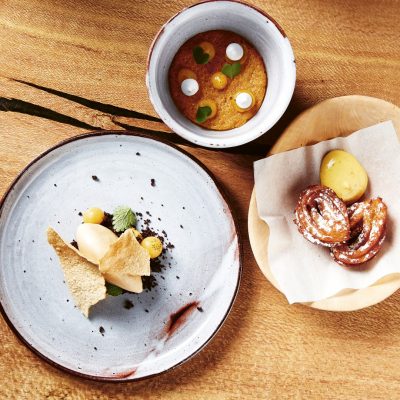
Madumbe, guavadilla and elachie
Serves: 4 | Preparation time: 1 hours, total time 6-12 hours
Paired with: Genevieve MCC Blanc de Blanc 2018. Winemaker: Melissa Genevieve Nelsen. This 100 per cent Chardonnay is delicate and fresh. Expect almonds and citrus, with great natural acidity for freshness and structure. It gives the Madumbe and guavadilla a beautiful, refreshing and light finish.
What you’’ll need:
Madumbe churros: 400g potatoes; 400g amadumbe; 200g butter; 200g water; 400g flour; 8 eggs; salt and sugar; 50g icing sugar
Guavadilla curd: 135g guavadilla juice; 2 eggs; 3 egg yolks; 135g sugar; 175g butter (cold, diced)
Vanilla Elachie ice cream: 1000g milk; 500g cream; 200g glucose; 5 toasted cloves of Elachie (cardamom); 250g egg yolk; 375g sugar
Garnish: Lemon balm; cloves
How to make:
Madumbe churros: Boil potatoes and madumbe until soft and press through a drumb sieve. To make a choux you’ll need a large saucepan. Over medium heat add water, butter and sugar and bring to the boil. Turn off the heat; add flour, salt, madumbe and potatoes. Stir with wooden spoon until thickened. Let mixture cool down. To cooled mixture using a hand mixer, beat in eggs one at a time until combined. Transfer mixture to a piping bag fitted with large open star tip. Heat oil and fry churros in hot oil until golden. Roll churros in icing sugar and place on a cooling tray.
Guavadilla curd: Mix guavadilla juice, eggs, egg yolks, vanilla and sugar and emulsify to 70 degrees. When emulsified, slowly add butter Elachie ice cream. Bring milk, cream, glucose, sugar and elachie to boil. Temper eggs (add 2 cups of hot mix to the eggs slowly and whisk). Add everything together in hot pot. Emulsify to 70 degrees (crème anglais). Freeze in ice cream churner or freezer.
To serve: Serve ice cream with guavadilla curd and use churros to dip. Garnish with lemon balm and cloves.

